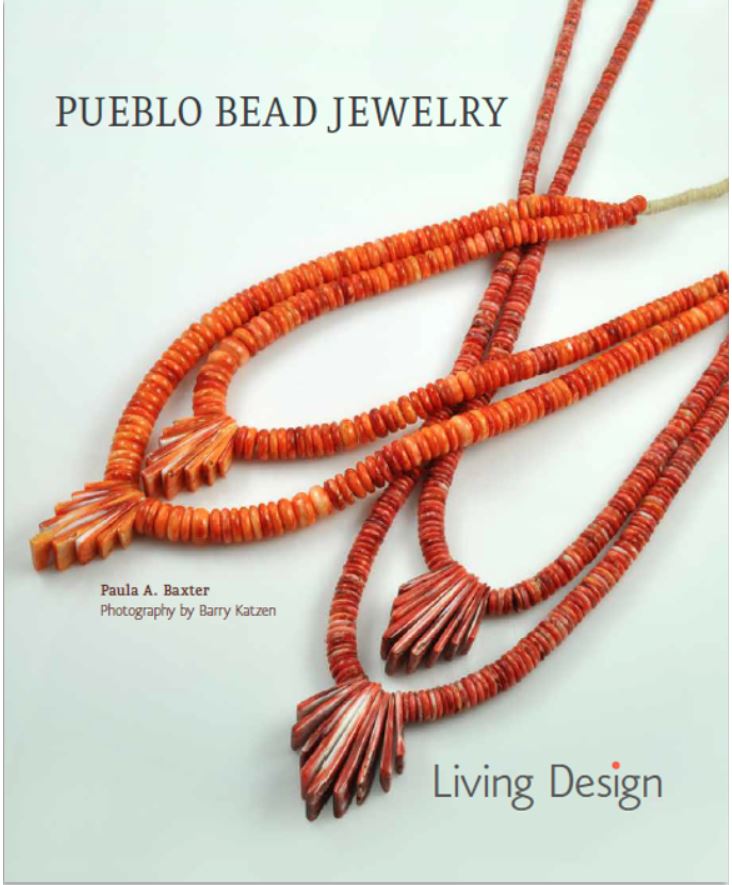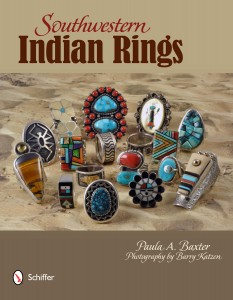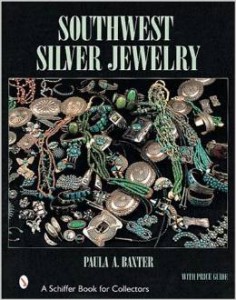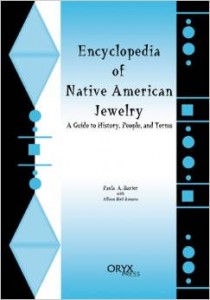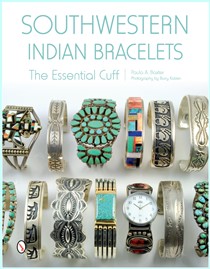Well, now the collector is amassing objects, and has begun to sort out some personal feelings about what is wanted and needed for a collection. The educational process begins around this point. I discovered that if I was going to spend my money like a drunken sailor, I did want to know more about the materials my object of desire was made with. For me, this meant learning about silver — coin silver, German silver, sterling silver, silver with alloys. Oh, and then, there’s the turquoise…
Books are needed! Once the collector becomes truly primed, the need to learn, evaluate, and judge based on knowledge becomes a driving force. In my case, it led me to begin writing on the subject when the variety of books out there wasn’t enough to satisfy my questions. Today, Amazon and the online used book market make the hunt for education an easier process than it was back in the 1980s.
One object isn’t enough, oh no! The new collector is ready to embark willy-nilly on a hunt for objects like the ones in his/her possession. Frankly, new collectors can’t get enough exposure to these objects. If you don’t live in the Southwest, you comb through local shops, dealers, and shows. It only took one trip for me to realize that big successful enterprises like the Brimfield (MA) antique shows are NOT the place to find one’s objects of desire. A savvy dealer has been there the day before and taken anything of note. New collectors need to understand these realities before expending too much manic energy in fruitless hunts.
Sometimes hunts prove beneficial after the fact. We started visiting trading posts on the Navajo reservation in the late 1980s and early 1990s. Some had already stopped being genuine sources for Indian arts. Yet we discovered an affordable and fantastic rug at the Crystal Trading Post and a saddle blanket at Shonto, and learned about the historical importance of trading posts, even though their day had passed by the mid-1970s. New posts, operating like galleries are less plentiful, but when you hunt down one like Twin Rocks Trading in Bluff, Utah, it’s like hitting a bulls-eye!
I’ve been working on a project related to why we become collectors. Certain interconnected things happen during this process. Having been through this, even though it was back in 1986, I still remember each development unfolding as clearly as if it took place yesterday.
Collector passion begins between a human being and an object or group of objects. I call this a first phase (a pun on the name of a period when antique Navajo weavings were first made.) The focus of the collector passion – a state of intense consumer desire – is on that object. For me, it was an Indian-made ring. Others make the discovery that their passion flares for a katsina carving, a clay pot, a piece of intricate beading, etc. Yes, we are talking about an inanimate object, something created.
A recent visit to Prescott brought us to the Smoki Museum. We’d just missed their annual Southwestern Native American arts festival, but wanted to see what this small museum holds. All of the exhibition space occupies one large hall, and there are numerous displays of pre-contact pottery, stone carvings, and ancient basketry. The “Smoki People” (pronounced “Smoke-eye”) were non-Native residents anxious to shore up their failing Prescott Rodeo; they devised their own version of the Hopi Snake Dance, dressed as Indians, and created an event that made money and brought its originators a certain amount of notoriety. It took until 1990 before the Hopi Tribal Council got this event shut down. The museum’s supporters are confirmed, however, in their desire to promote Native cultures. The Smoki Museum is worth a little under an hour of exploration, and it illuminates social attitudes in Arizona before political correctness became established as the right way to celebrate Native achievement.
Despite the presence of the Yavapai-Prescott Indian Reservation, the small town of Prescott, Arizona, possesses a rural Western aspect, making the ambience more Cowboy than Indian. That said, Prescott holds attraction for the lover of Indian Country. Whether that translates into enjoying Bucky’s or Yavapai Casino or wandering the many small shops that ring Prescott’s town green, there are things to be seen and purchased.
Ogg’s Hogan, on Cortez Street, is filled with vintage collectibles that glitter as appealingly as those goods featured in Cowboys and Indians magazine. I spotted tote bags fashioned from Navajo textiles alongside shiny spurs and rodeo gear. The owner used to work for the Fred Harvey Company, and ran Hopi House on the Grand Canyon’s South Rim. Other stores in town feature Native-made goods (along with imitation Indian-made items), although the ratio is smaller in comparison to merchandise in the Southwestern Style intended for Western culture buffs.
We still remember that tourist from Europe we ran into in Scottsdale a year ago who wanted to know where “all the Indians” lived and worked! Someone we’ve known for a while, who resides in Prescott, is a Native equally at home in his traditional society and in the wider world of art, antiques, and collectibles. We’re referring to talented Navajo silversmith and jeweler Ernie Lister, who runs a small antiques shop off the lobby of the Montezuma Hotel, a historic old-time lodging place. His Hotel Trading Company features tantalizing Native and non-Native vintage works, from concha belts to pottery to estate jewelry and adornment.
While he minds the store, Ernie also runs his work bench, from which spot he fashions delectable silver and stone creations. He’s a top-of-the-line artist, able to switch back and forth from old style to avant-garde forms, whose works are sought by collectors at home and abroad (he has a following in Japan). One of his pieces appears in our forthcoming book Southwestern Indian Rings (Schiffer, November 2011). Lister is a refreshing example of a Native art expert in Indian country, and a change from the non-Native dealers who dominate the vintage Indian arts market.
A trip to Tucson for those touring Indian Country should take in Grey Dog Trading Company. Run by Kent McManis, the Native-made stone carvings you find here are chosen by THE expert. McManus and his wife have authored a number of key reference publications on Zuni stone fetishes. Their research and knowledge of the subject are prized by collectors around the country (one from New York City called during one of our visits). McManus personally knows virtually all the carvers of Zuni Pueblo, and has worked over the years to trace and place key artists within their complicated web of family relationships.
McManus has a limited amount of jewelry in his shop, a careful selection of fetishes (he travels to Zuni every month), and in recent years has begun carrying a small but remarkable number of Inuit carvings. Every piece in Grey Dog Trading has been chosen by someone with a master collector’s discerning eye.
The souvenir nature of low-end Indian arts, spurious vendors holding travelling Indian arts shows with questionable goods, and bogus sales discounts of 50% or more off already jacked-up prices, have all contributed an aura of sleaze to the marketplace. Sadly, many tourists consider the awful things they see in tourist stores as representative of the genuine article. This problem is so endemic, even the U.S. government has gotten into the protectionism business. The Indian Arts and Crafts Act of 1990, P.L. 101-644, co-sponsored by Congressman Ben Nighthorse Campbell, a Southern Cheyenne jeweler by profession, put in place a truth-in-advertising law that prohibits misrepresentation in the marketing of Indian arts. Over the past decade, New Mexico and Arizona have passed state laws related to this federal act, yet the verdict is out on how successful and consistent enforcement will be. Until then, be careful what you buy.
Watch a video about buying authentic Indian Arts and Crafts.
Download a brochure (PDF) about “How to Buy Genuine American Indian Arts and Crafts.”
Cowboys and Indians is one of the most popular glossy magazines on the market, and has high circulation numbers. We enjoy looking at the magazine for its intriguing articles on the western lifestyle and its sumptuous color advertisements. The popularity of Cowboys and Indians, however, also reminds us of the need for clarification. Many people see jewelry that looks like contemporary Native American designs and draw the conclusion that this adornment is Native-made. In many cases, it’s simply not so. Non-native silversmiths and jewelers work in a design mode that can be variously labeled “Southwestern Style” or “Santa Fe Style.” This mode shares many similarities to Indian-made jewelry, especially in terms of jewelry forms like bracelet cuffs, rings, and bolo ties. One major non-Native designer of note is Rocki Gorman, who now has a boutique inside the famed Hotel La Fonda in Santa Fe.
One of the best things about Native-made textiles is in the detail. Today’s weavers use opportunities to pull the viewer in with a small touch. Such an image is often organic, ranging from rain clouds to rabbits. Don’t forget to check out the Crownpoint Rug Auctions if you plan to be in western New Mexico.
Exhibitions like “A Turning Point,” currently at the Heard Museum, point out essential information. Navajo weavings are famed for their unexpected narrative elements, usually in keeping with the overall design.


